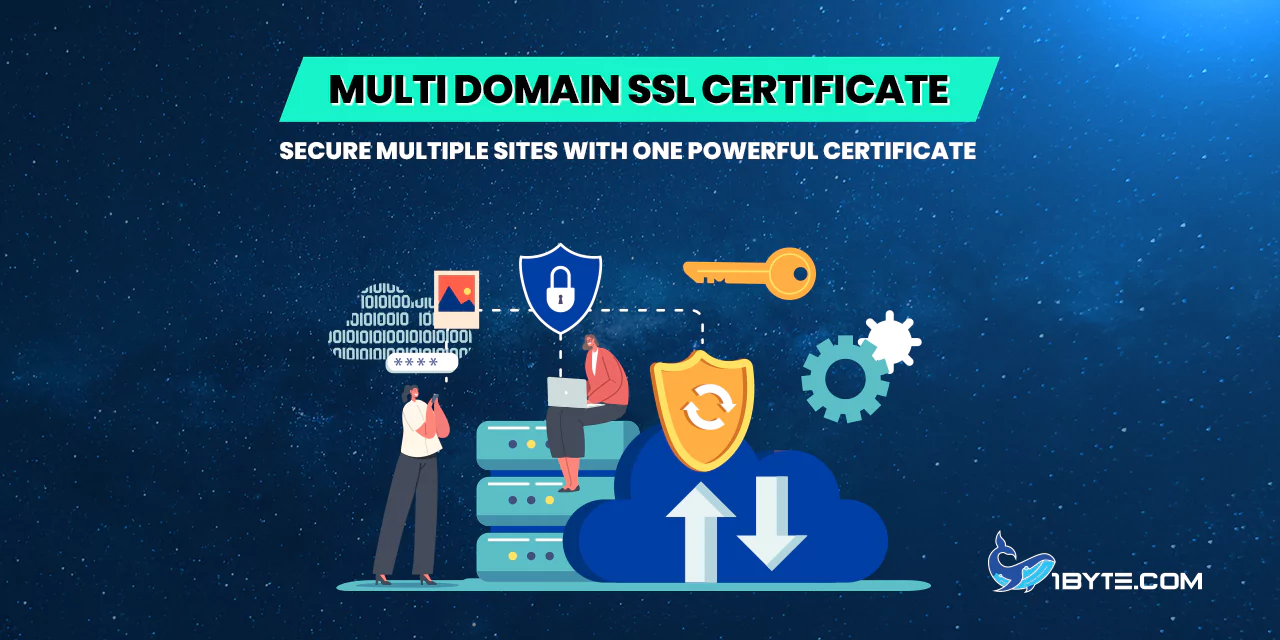Organizations that host multiple websites have a big challenge. Each site should be secured with HTTPS, but maintaining separate SSL certificates for each domain can be expensive and complicated. A multi domain SSL certificate solves this problem. Wildcard certificate is a single digital certificate that is valid for multiple domain names and subdomains. This type of certificate is also called a SAN (Subject Alternative Name) or UCC (Unified Communications Certificate) certificate. SSL certificates enable companies to encrypt traffic for multiple websites with a single powerful certificate, which reduces costs and administrative effort.
A multi domain SSL certificate works by including a list of all the domain names in its SAN field. When a user’s browser connects to any secured domain it verifies the certificate and checks that the domain is in the SAN. This verifies the encrypted connection to be valid for every site on the certificate. For example, a single certificate can cover www.example.com, blog.example.net and mail.example.org. When visitors visit any of these sites, the SSL connection is trusted and the data is protected. In practice, this means that all of those domains will have the padlock icon and “https” in the browser for the web user.
Multi domain certificates manage multiple domains on one server or on different servers. They are particularly handy for businesses that have multiple web properties. A large organization may use the same SAN certificate for its main site, its store site, and its email servers, simultaneously. From a security perspective, all the protected domains have the same level of encryption and validation. This means that regardless of which of the secured sites the visitor navigates to, the connection is encrypted and trusted. Read this article from 1Byte to learn more.
How Multi Domain SSL Certificates Work
To implement a multi domain SSL certificate, the first step is to gather all domain names to secure. The certificate request (CSR) is generated per domain specified in the SAN field. The certificate authority (CA) then verifies that each domain is owned by the person or organization that registered it. Once the certificate has been issued, it is installed on the web server(s). The SSL certificate now includes all the host names listed in its digital signature.

For instance, let’s say that a company wants to secure the following sites: www.domain-one.com, mail.domain-one.com, and domain-two.com. The IT team creates one certificate request with all three names. After each domain is verified by CA, the issued certificate can be installed on one or more servers. When a user visits www.domain-one.com their browser will verify the certificate. It knows that www.domain-one.com is a valid SAN entry, and creates a secure connection. The same is true for mail.domain-one.com and domain-two.com. All these sites now share a common certificate.
Technically, multi domain certificates are X.509 extensions. The SAN entries are part of the data of the certificate. Modern browsers will accept this and will accept the certificate for all of the names covered. This approach can also be used for various degrees of validation. Multi-domain certificates include Domain Validated (DV), Organization Validated (OV) or Extended Validation (EV) certificates. In fact, multi-domain certificates can be EV, which gives the “green bar” of high trust to all sites listed on the certificate (unlike wildcards, which cannot be EV).
Benefits of Multi Domain SSL Certificates
Using one SSL certificate for many sites brings several advantages:
- Cost Efficiency: Purchasing a multi-domain SSL certificate is usually more cost-effective than buying multiple single-domain certificates. You pay one time for one certificate instead of paying for each domain individually. This saves you the purchase price and renewal fees. For example, some certificate authorities provide SAN certificates covering 250 domains for a set price.
- Simplified Management: It is easier to manage one certificate than multiple certificates. IT teams monitor a single expiry and renewal process rather than multiple deadlines This eliminates administrative tasks and minimizes the risk of a certificate going unused and unnoticed before it expires. One market report states that SAN certificates are used in large sites where multiple domains are protected with a single certificate, “thereby reducing administrative effort while ensuring strict security.”
- Broader Protection: A multi-domain certificate includes multiple domain names and subdomains. It has multiple websites, applications or services under one SSL. For example, a company might register example.com, example.org and app.example.net simultaneously. This flexibility means that different websites or parts of a business can be secure without having to buy or install separately.
- Flexibility and Trust: Multi-domain certificates are offered at all levels of validation (DV, OV, EV). A business can opt for a higher validation (OV or EV) to instill confidence in users across all its sites. In practice, an EV multi-domain certificate is just like a normal EV certificate, showing company information in the browser and giving users confidence.
- Versatility: Multi-domain SSL certificates usually come with a predefined number of SANs, and you can add more SANs if required. They can also be used together with wildcard entries for subdomains if the certificate type supports that. This makes them a general purpose solution for complex domain configurations.
In short, multi-domain SSL certificates reduce costs and complexity while keeping strong encryption in place across many sites. As one market analysis puts it, “Multi-Domain SSL Certificates … allow businesses to secure multiple domains and subdomains under a single certificate, offering significant cost and administrative efficiencies”.
Multi Domain vs. Wildcard SSL Certificates

It’s useful to compare multi-domain certificates to another type of SSL, called wildcard certificates. A wildcard certificate protects one domain and all its subdomains (at one level). For example, shop.example.com and blog.example.com can be secured by *.example.com. A wildcard does not match different root domains.
- Coverage: A multi-domain certificate covers multiple domains on the same certificate. Wildcard certificate protects all subdomains of a domain. For example, one SAN certificate might cover www.siteA.com and www.siteB.com at the same time. By contrast, a wildcard certificate such as *.siteA.com would include blog.siteA.com and shop.siteA.com, but not siteB.com.
- Limits: Multi-domain certificates usually only support a set number of names (usually 250 or more depending on the CA). Wildcards are used to make an unlimited number of subdomains at the specified level but for a single domain. In other words, you select a multi-domain if you have multiple different names and wildcard if you have many subdomains of one site.
- Validation Levels: Multi-domain certificates can be validated at the Extended Validation (EV) level as each domain is listed explicitly. Wildcard certificates are not allowed to be EV under current rules. All three DV/OV/EV validation levels are available for multi-domain (and single-domain) certificates, providing businesses with flexibility in the level of trust.
- Use Case: If a company owns multiple different websites, a multi-domain certificate is the way to go. If it is one primary site with a lot of sub-sites, a wildcard may work. For instance, an entrepreneur who has three different websites (site1.com, site2.net, site3.org) can secure all three of them with a single SAN certificate. On the other hand, *.company.com would not secure company.net, only subdomains of company.com.
These differences mean that multi-domain certificates are best when there are diverse domain names, whereas wildcards are for multiple subdomains of a single domain. Both approaches simplify SSL management, but they solve slightly different problems.
Use Cases and Examples
Multi-domain SSL certificates are used for a lot of real-world applications. For example, a business that has one main website and separate sections for its blog, store, and mobile app, can use a single certificate to secure all three domains. A retailer can purchase shop.example.com, blog.example.com and secure.example.net simultaneously.
A common example would be a company that entered new markets and created new domain names. Rather than buying new certificates, it simply adds those domains to its existing multi-domain certificate. Another example is an email and services server. The same certificate could be used to secure mail, web and FTP servers (on different hostnames) within an organization. For example, one certificate may contain mail.domain-one.com and ftp.domain-one.com as well as the main site www.domain-one.com.
Demand is also being driven by cloud services and unified communications. Companies that use Microsoft Exchange or Skype for Business often require certificates that contain multiple domain names (including service names such as autodiscover.example.com or mail.example.com). This is precisely what Unified Communications Certificates (a multi-domain cert) were meant to be. In fact, one SSL guide says that multi-domain certs secure an e-commerce site and its payment subdomain with the same certificate by listing them in the SAN field.
Overall, any organization running multiple hosted services or brand websites can benefit. The examples above are illustrative, and in practice these certificates can cover dozens of hostnames if configured (some allow up to 250 names).
How to Implement a Multi Domain SSL Certificate
Putting a multi-domain certificate in place involves a few key steps:
- Plan Your Domain List: Make a list of all the domains and subdomains that you need to secure. Make sure that you have control over each one and can access them. For example, you can add your main site example.com, blog.example.com, shop.example.org, etc.
- Generate a CSR with SANs: Create a Certificate Signing Request (CSR) with all the domains in the SAN (Subject Alternative Name) field. This tells the CA what names to add to the SSL certificate.
- Validation: Full CA domain validation for each name If it’s DV, you may add DNS records or reply to emails for each domain. For OV/EV certificates, all domains need to be included in the organization documents.
- Receive and Install Certificate: After the certificate is issued by the CA, you can download it and install it on your server(s). The same certificate file (with its private key) can be used wherever it’s required. Log in to your web server configuration and change it so that each domain is using the new certificate. Go to each site and look for the secure padlock icon.
- Renewal and Maintenance: Keep a check on the expiry date of the certificate Because one certificate is used for all sites, if you renew it, it extends the security for all domains at the same time. Some providers allow ACME or management tools for automation of renewal.
These measures ensure that each site is properly encrypted. The process is the same as a standard SSL install, the only difference is that the CSR and certificate contains multiple names.
Industry Trends and Statistics

SSL/TLS adoption has become nearly universal. As of mid-2025, an estimated 88.5% of all websites use HTTPS by default. This widespread adoption means businesses of all sizes are using SSL to protect data. In fact, industry data shows roughly 82.9% of websites had valid SSL certificates in 2023, up from only 18.5% five years earlier. Google’s index has confirmed that over 95% of its listed sites support HTTPS. These trends underscore that encryption is now a basic requirement for trust and SEO.
Market research indicates that multi-domain SSL certificates are a fast-growing part of this trend. A recent SSL market analysis reports that “Multi-Domain SSL Certificates … are the fastest-growing category in the SSL certificate market.” It attributes this to enterprises expanding their online presence: businesses need to secure more domains, and SAN certificates meet that need cost-effectively. Coherent Market Insights also notes that as organizations handle more domains and subdomains, demand for wildcard and multi-domain certificates is on the rise.
On the supply side, this demand is met by certificate authorities. Some CAs have the ability to host multiple domain entries on a single certificate. For instance, some multi-domain SSL products allow you to have up to 250 different domains on one certificate. Even free CAs like Let’s Encrypt support multi-domain certificates (up to 100 names per certificate). These capabilities enable small and large businesses alike to use one certificate for different sites.
These numbers show a clear trend: SSL is on the rise, and multi-domain certificates are helping to keep pace with the growth. By cutting administrative overhead and cost, they are encouraging organizations to encrypt everything.
Leverage 1Byte’s strong cloud computing expertise to boost your business in a big way
1Byte provides complete domain registration services that include dedicated support staff, educated customer care, reasonable costs, as well as a domain price search tool.
Elevate your online security with 1Byte's SSL Service. Unparalleled protection, seamless integration, and peace of mind for your digital journey.
No matter the cloud server package you pick, you can rely on 1Byte for dependability, privacy, security, and a stress-free experience that is essential for successful businesses.
Choosing us as your shared hosting provider allows you to get excellent value for your money while enjoying the same level of quality and functionality as more expensive options.
Through highly flexible programs, 1Byte's cutting-edge cloud hosting gives great solutions to small and medium-sized businesses faster, more securely, and at reduced costs.
Stay ahead of the competition with 1Byte's innovative WordPress hosting services. Our feature-rich plans and unmatched reliability ensure your website stands out and delivers an unforgettable user experience.
As an official AWS Partner, one of our primary responsibilities is to assist businesses in modernizing their operations and make the most of their journeys to the cloud with AWS.
Conclusion
A multi domain SSL certificate is a powerful tool for securing multiple websites with one solution. This simplifies certificate management, reduces costs and ensures security of all domains. As encryption on the web has become widespread, these certificates have become popular. In fact, they are mentioned in industry reports as the fastest growing segment of SSL usage. For any business that runs multiple web properties (be it different country sites, brand sites or service names), a multi-domain certificate is an efficient and effective way to enable HTTPS everywhere.
Key takeaways: Multi-domain SSL certificates allow organizations to secure multiple domains and subdomains with a single certificate. They save money and time by not having to issue individual certificates. They provide all levels of validation (DV, OV, EV) and provide trust for all the sites listed. As evidence, recent surveys and market reports indicate that the use of such certificates has increased and HTTPS is widely adopted. In other words, a multi-domain certificate can be used to secure multiple websites, making HTTPS more manageable and scalable.

